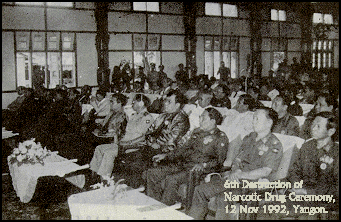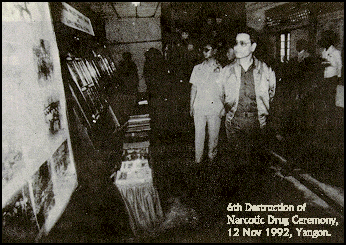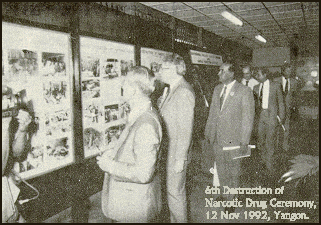6th Destruction of Narcotic
Drugs Ceremony – 12th November 1992, Yangon
Participants:
-
Secretary-1 of the State Law and Order Restoration Council and members -
Department Heads and Invited Guest -
Resident Representatives of UN agencies -
Diplomats and Military Attaches -
Foreign Media Personnel -
Local Media Personnel -
Invited Guest

Report made by the Central Committee for Drug
Abuse Control
Presentation By Pol. Col. Ngwe Soe Tun, Joint Secretary of CCDAC at The
Sixth Destruction Of Narcotic Drugs Seized By Law Enforcement Agencies.Chariman of CCDAC and members, Secretary-1 of SLORC and Department Heads,
Resident Representatives of the United Nations Agencies, Diplomats, Military
Attaches, Local and Foreign Journalists and Invited Guests,

First, I would like to introduce my self to you. I am Joint Secretary of
CCDAC well as Director of CCDAC and Law Enforcement Department of People’s
Police Force. I am going to present two portions at this significant ceremony.The first deals with the policy and measures regarding drugs enforcement
activities during the four-year period from 18 September 1988 to 17 September
1992, laid down and taken by Army after the assumption of the State
responsibilities.Distinguished Guests,
The second part is related to today’s destruction of narcotic drugs which
will presented by Pol. Col. Maung Maung Than, Commander of the Criminal
Investigation Department as well as member of Law Enforcement Sector,
responsible for the analysis, storage and destruction of narcotic drugs.As first part, there are two objectives towards our policy in drug abuse
control. The first Objective is that as the border areas and national races
become developed, the cultivation of opium poppy will gradually be eradicated.The questions where and how many, poppy plantations are cultivated and who
involves in cultivation in our country are frequently asked. Please permit me
to answer officially these questions at this ceremony.

Most of the poppy plantations are grown along the border areas in the east
our country such as Myanmar/ China, Myanmar/ Laos and Myanmar/ Thailand
borders. Myanmar is connected with the areas of China in 1,357- mile length,
while connected with Laos in 146-mile length and Myanmar/ Thailand in 1,314
mile length. The total length of the border areas is 2,817 miles connected
with the neighbouring countries. Out of such over three thousand miles in
length of border areas, opium poppy cultivation can be found in some areas in
the east of Myitkyina and Banmaw in Shan ite, Kokang region, Wa region, east
of Kengtung, Mongyawng and southern Mongtong, Mongsat regions in Shan State.
In some inner areas, a few poppy fields can be found cultivated. As based on
the ground reconnaissance, a total of 65,568.14 acres of opium poppy is grown
in 1991-92 season. During that period, 2,550 acres in Kokang region 13,286
acres in Wa region have been destroyed while 3,113 acres have been eliminated
the other regions. Thus, we can destroy 8,949 acres of poppy fields (nearly
ten thousand) in this season.In order to know accurate data on how many poppy fields are cultivated, it
is better to use modern techniques rather than only ground reconnaissance.In our country, it is estimated that there will be over 0.3 million of
poppy growers, who are hilltribe national races, living in the border areas.
The problem they are mainly facing is how to get their subsistence without
growing opium poppy. Otherwise, what we have to give priority on them is to
provide their subsistence, to change ideology and to develop their knowledge
for their new lives.In this regard, the Commander in Chief, General Than Shwe (former Chief of
Staff Army) gave a guideline to the delegation to the Special Session of
Commission on Narcotic Drugs, led by Col. Thura Pe Aung on 3rd. of December
1989.He said, “In the hilly regions, opium poppy was cultivated not only
for money but also for traditional medicinal purpose. They had no willing to
grow other crops rather than opium poppy which is easy to carry and to earn
money in a short term. The destruction of poppy fields may cause to the hatred
of the national races and to the disintegration of national unity. Thus, the
insurgent groups can easily organize them. We, therefore, have to make
feasible integration of their living standard. This will also lead to the
effective crop substitution. In doing so, we should make plans for their
easiness to earn money by short-term plan rather than long-term plans. During
the period of short-term plan, the State should take responsibilities for
their livelihood. On the other hand, agricultural techniques and supports for
their socioeconomic development should be provided. The success by short-term
plans should be kept continuous by the long-term plans. Thus, they will give
up poppy growing gradually. We, formerly, had been living with the national
races in the frontiers and had supported their socioeconomic needs. So, as
much as we can implement the development programmes for the poppy growers, the
poppy growing will gradually be eliminated and narcotic drugs will be
eradicated”.Recognizing this, border areas and national races development programmes
have been initiated in five States and one Division since 25th of May 1989
forming the central committee. Recently, it has been reformed as a Ministry
and marked as a main task of the State for border areas and national races
development.Distinguished Guests,
Statistically, the State has invested kyats 1.025 million for the border
areas and national races development during the period from 1989 to 1992. It
has opened-
31 – hospitals and
-
68 – dispensaries,
-
68 – electrical power plants and
-
7 – hydropower plants,
-
73 – agricultural stations,
-
41 – dams and cannels,
-
10 – tractor depots,
-
12 – saw mills,
-
11 – nursery forests,
-
15 – livestock farms,
-
6 – fish farms and
-
54 – fish ponds.
It has already distributed mules for 14 times. Altogether,-
786 miles of earth roads,
-
738 miles of gravel roads and
-
18 miles of asphalt roads have been constructed and
-
3,325 miles of roads have been maintained in the border regions.
Along the roads,-
13 – big bridges and
-
296 – small bridges have been built.
It has also opened-
6 – post offices,
-
24 – radio telegraphic stations,
-
22 – telephone exchanges,
-
137- miles of telephone lines,
-
4 – relay stations,
-
17 – telephone offices,
-
9 – domestic satellite stations,
-
11 – communication buildings,
-
7 – TV relay stations,
-
3 – TV receiver stations.
The State has also assigned duties to 1,749 government officials in border
areas.
The estimate has been approved to spend 890.29 million kyats for the period
between 1992 and 1996. Thus you can vibidly see momentum gained by our efforts
for the development of border areas and national races during such a
short-term period.Distinguished Guests,
With the satisfaction on our efforts, UNDP collaborated with us in the
opment programme of border areas and national races under the three year
project. Project areas are Kokang, Wa and east of Kengtung areas. UNDP
contributed 0.68 US dollars and Myanmar’s input is 2.06 million kyats.Likewise, Myanmar Agriculture Service has made an agreement with UNDP rural
development Programmes in Kokang, Wa and east July 1991. Under the agreement,
UNDP will provide at Myanmar will put 1.7 million kyats in the project.
Distinguished Guests,
Crop substitution and livestock breeding programmes are taken as follows.
In Kokang, Wa and east of Kengtung regions,-
25 – base stations have been opened and
-
307 – agricultural staff are assigned.
In model stations, there cultivated-
135 – acres of annual crops and
-
261 – acres of perennial crops.
-
3,516 – baskets of annual seeds,
-
4.4 – million seedlings of coffee, tea, orange and cashewnuts,
-
1,066 – tonnes of fertilizers,
-
830 – gallons of weedkiller,
-
113,465 – pounds of fungicides and
-
10,491 – farm implements have been distributed to the farmers in the
border areas.
Sixty-eight training courses have been conducted for the 4,200 farmers.
14,540 acres have been developed and 28,483 acres of annual crops and 3,352
acres of perennial crops have been cultivated. Coffee research has been made
on 60 acres in Pyin-oo-lwin and tea research has been made on 58 acres in
Pinlaung.Distinguished Guests,
Livestock farms are established in Loikaw, Heho, Naungcho, Taryaw, Phekon,
Kengtung, Lashio and Kuniong. Forward stations have been established in Mawpha,
Mongma, Mongyu, Silu and Sinkyaue. 21,985 poultry, 599 pigs, 219 cattle and 38
mules are raised in these farms. From these farms, 96,447 poultry, 1,495 pigs,
205 cattle and 3 donkeys have been distributed to the farmers.Distinguished Guests,
Cultivation of poppy, production of heroin and trafficking were formerly
run by the insurgent groups. The areas which I have presented were, in those
days, influenced by the insurgent groups. But, sirce 1989, the leaders of
national races have driven the insurgent groups away and joined hands with us
for the development of their regions.Under the supervision of the Committee for Border Areas and National Races
Development, the national races and their leaders have laid down and
implemented 6 years plan in Kokang region and 10-year plan in Wa region for
the eradication of narcotic drugs.Otherwise, we are taking these measures in line with the following three
main causes;-
Non-disintegration of the Union,
-
Non-disintegration of National Solidarity,
-
Consolidation of National Soverignty.
Such unity of the national races has led to the destruction of narcotic
drug refineries and chemicals by the national races on their volition. Such
ceremonies h been held for four times, while convening destruction of poppy
fields for three times. The national races in Kokang areas have uncovered
three refineries during the said per These have been witnessed by the
personnel from UN Agencies, diplcfnats and speci invited foreign journalists
who have become to know the truth. Oui efforts prove self-help basis in wiping
out narcotic drugs, without depending on others. Now, we gain beneficiaries
from our own efforts which have been taken by ourselves without blaming on
others.Distinguished Guests,
The 17th Special Session on Narcotic Drugs of United Nations General
Assembly had passed a resolution to cooperate and coordinate each other in
combating narcotic drugs. In accordance with this resolution, we have signed
agreements to collaborate with the i;eighbouring countries such as China and
Thailand on 12 June 1992. In near future, such agreement will be signed
between us and Laos and bilateral cooperation will be carried out between us
and India. The three-year project will begin in January 1993 in Silu, Pangkai,
Mongla and Ahdee, Sanlu areas in Shan State under the projects-Myanmar/China
and Myanmar/ Thailand. The objectives of the projects are to eradicate
narcotic drop along the border areas and to carry out development programme in
the remote areas. For the two projects, the United Nations will provide 12
million US dollars.Distinguished Guests,
The accession to the 1988 United Nations Convention against Illicit Traffic
in Narcotic Drugs and Psychotropic Substances has been deposited on 11 June
1991 to the Secretary General of the United Nations. This proves our
international cooperative efforts.Distinguished Guests,
The second objective, I would like to present is to eradicate narcotic
drugs as a national duty under the multi-sectorial basis. There stands Law
Enforcement Sector under the CCDAC. The Task Force Units in Yangon, Mandalay,
Lashio, Taunggyi and Kengtung were established-in 1985 and they were put under
the command of the Divisional and State Police Commanders. After 18 September
1988, the operational command of Task Force Units was put under the People’s
Police Force Headquarters. Furthermore, Task Force Units in Monywa, Katha,
Kalay in 1988, four Task Force Units in Myitkyina, Yangon Airport Sittwe and
Myeik in 1989, two units in Pathein and Mawlamying in 1990 and one unit in
Homelin in 1991 have been extended on self-help Operations Yeminaiang phase I,
II, Nemin, Gonban, Tagun phase I to VI have been carried out by these Task
Force Units. Such operations have gained momentum in a certain extent.Distinguished Guests,
The seizures made during the four years period, which have been released
radio and in newspapers are-
825.99 kilos of heroin in 7,157 cases,
-
6,269.99 kilos am in 2,993 cases,
-
81.78 kilos of liquid opium in 11 cases,
-
70.62 kilos of morphine ases,
-
24.71 kilos of opium oil in 162 cases,
-
58.69 kilos of Beinzar powder in 27
-
22,544.26 kilos of marijuana in 3,364 cases and
-
19,969.89 litres of Phensedyl in cases.
The Second part which deals with the destruction of narcotic drugs fromerly
resently will be presented by Pol. Col. Maung Maung Than who is a member of
enforcement Sector under the CCDAC.
Thank You.
PRESENTATION BY POL. COL. MAUNG MAUNG THAN,
COMMANDER OF CRIMINAL INVESTIGATION DEPARTMENT, MEMBER OF LAW ENFORCEMENT
SECTOR
Distinguished Guests,
I am Pol. Col. Maung Maung Than, Commander of Criminal Investigation
Department and member of Law Enforcement Sector under the CCDAC.
Distinguished Guests,
Today, the narcotic drugs, to be destroyed at the Sixth Exhibition on
Destruction of Narcotic Drugs are;-
115.354 – kilos of heroin,
-
5,090.781 – kilos of opium,
-
34.470 – kilos f morphine,
-
1.847 – kilos of opium oil,
-
0.514 – kilos of liquid opium,
-
292.681 – kilos of Marijuana and
-
1,449.125 – litres of Phensedyl in 11,427 bottles.
Distinguished Guests,
Such exhibitions have been held since 13th of February 1990 and now for six
times at this same place. Altogether-
927.193 – kilos of heroin,
-
5,090.781- kilos of opium,
-
7.937 – kilos of opium oil,
-
112.699 – kilos of liquid opium,
-
63.435 – kilos of morphine,
-
3,107.6 – kilos of marijuana,
-
17,694.62 – litres of Phensedyl,
-
39.78 – litres of Corex and
-
8.05 – litres of Glycodine have been destroyed up to now.
Similarly, according to the programme of supply reduction by national races
i the border areas, the ceremony has been held for seven times. Altogether-
304.85 – kilos of heroin,
-
327.28 – kilos of opium,
-
181 – kilos of morphine,
-
7,336 – acres of poppy fields nd seven refineries have been destroyed.
Distinguished Guests,
Up date, the destruction totals 13 times– six times in Yangon and seven
times in border areas–. At those ceremonies,
-
1,232.05 – kilos of heroin,
-
5,418.061 – kilos of opium,
-
44.44 – kilos of morphine,
-
47.937 – kilos of opium oil,
-
112.699 – kilos of liquid opium,
-
3,107.6 – kilos of marijuana,
-
17,694.625 – litres of Phensedyl,
-
39.78 – litres of Corex and
-
8.05 – litres of Glycodine,
-
7,336 – acres of opium poppy and
-
7 – refineries have been destroyed.
Distinguished Guests,
The Criminal Investigation Department is carrying out the measures with
regard registration of the drug-related offenders, finding out the previous
offences, analysis f narcotic drugs seized by law enforcement agencies,
storage of drugs deposited by the tate and Division People’s Police Force,
management of deposited drugs and destruction etc.Distinguished Guests,
The narcotic drugs to be destroyed in this exhibition are those deposited
up 31st of October 1992, including over five thousand kilos of opium.Distinguished Guests,
Please may I conclude, declaring that the narcotic drugs seized by law
enforceent agencies will be destroyed like this in future, whenever the
Opportunity permits us.
Thank you.
-